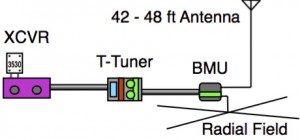As part of project LOAP (Lipstick On A Pig ===> http://vtenn.com/Blog/?p=1348), I wanted a small cheap matching and SWR indication unit for the Pixie-based transceiver system. The T-Tuner and SWR bridge unit on the right, in the picture below, is not vastly different from others, but here it is for your consideration as a good performer at a low cost. Note however, that it has been characterized into real-world impedances with a worst-case loss of less than 0.9 dB.
 This unit has been run with 5 Watts CW for long periods into the load impedances presented by a BMU matched 43 to 48 foot vertical, sloper, or Inverted-L. All bands are easily and efficiently matched on 80 M to 10 M ham bands.. The corresponding QRP Base Matching Unit (BMU) is described here ===> http://vtenn.com/Blog/?p=1562
This unit has been run with 5 Watts CW for long periods into the load impedances presented by a BMU matched 43 to 48 foot vertical, sloper, or Inverted-L. All bands are easily and efficiently matched on 80 M to 10 M ham bands.. The corresponding QRP Base Matching Unit (BMU) is described here ===> http://vtenn.com/Blog/?p=1562
Above is the block diagram of the QRP system. Note that the BMU is placed at the Base of the antenna.
Here is the schematic of the QRP Portable T-Tuner and SWR Bridge ===>
Note that the standard 50 Ohm SWR bridge shown above uses a 270 ohm resistor at “R Led” for operation at the 1 Watt level. This resistor must be increased in value for higher power operation.
The “Tapped Powdered Iron Toroid” used in this design is a T68-6. It has 40 turns total, and is tapped as follows:
5 T – 0.23 uH – connected to S8
6 T – 0.30 uH – connected to S7
8 T – 0.47 uH – connected to S6
11 T – 0.79 uH – connected to S5
15 T – 1.36 uH – connected to S4
20 T – 2.27 uH – connected to S3
25 T – 3.70 uH – connected to S2
33 T – 5.70 uH – connected to S1
40 T – 8.05 uH – connected to variable capacitor T-junction
Note that the dirt-cheap DIP switch used in the unit pictured is a surplus unit and was more or less tried as an experiment to see if it would reliably work – which it has thus far to at least 5 watts. However the voltage spec for the unit pictured is lower than voltages actually encountered. It would be a good idea to use a DIP switch or rotary switch with proper specs in the neighborhood of 50 volts or more.
 The miniature variable capacitors are available in various capacitance values on eBay, generally for less than $3 apiece. Cores are available from standard parts suppliers like DigiKey or direct from Amidon at a few $ each.
The miniature variable capacitors are available in various capacitance values on eBay, generally for less than $3 apiece. Cores are available from standard parts suppliers like DigiKey or direct from Amidon at a few $ each.
LOSSES
Efficiency of the unit into actual impedances presented by a BMU connected to actual antenna imnpedances was measured using the first step in the procedure shown in the article “Z-Substitution” Method for Measuring UNUN Loss Into Real-World Load Impedances”. Loss for both of the unis above was virtually identical. Since the impedance seen by the T-Tuner is a function of the length of the transmission line between the BMU and the tuner, actual loss values will vary. Losses shown below are for a short coax line of 4 feet:
80 M / 75 M: -0.32 dB
60 M: -0.90 dB
40 M: -0.85 dB
30 M: -0.22 dB
20 M: -0.85 dB
17 M: -0.65 dB
15 M: -0.73 dB
12 M: -0.30 dB
10 M: -0.30 dB
Copyright Dave Benzel- KD6RF – 2017 Mar 2
6,915 total views, 3 views today


